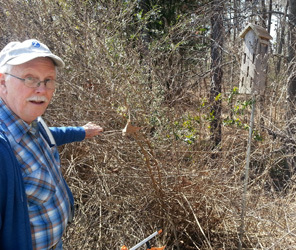Sounding the Alarm for Monarch Butterflies
By Environmental Management System
April, 2014
Have you seen any monarch butterflies recently? Monarch butterflies pass through North Carolina twice a year on their biannual migration. Each fall, monarch butterflies leave their summer home in the northeast United States and southern Canada and travel more than two thousand miles over two months to their winter hibernation home in Mexico, before migrating north again in the spring. Monarch butterflies also migrate from north California to southern California. This yearly migration occurs across three to four generations of the butterfly; each year, 35 million butterflies migrate to the exact location as previous generations did, even though no individual butterfly has ever made the journey before.

Map courtesy of USGS and graphic based off of USDA
Unfortunately, monarch butterfly numbers are in decline and the decrease in migration over the past ten years has been steep and steady. Climate change and habitat alteration have impacted the survival of monarch butterflies during hibernation and their summer location in Mexico. Furthermore, monarchs only lay their eggs on milkweed, which is disappearing from their migratory path, as pesticides and herbicides (especially those used on genetically engineered crops such as Roundup-ready corn and soybeans) kill milkweed and other non-crop species that used to sprout between plants. Developing caterpillars are also dependent on milk weed plants for food.

Photo courtesy of Carly & Art

Photo courtesy of Claire Long
If you have a garden, consider planting nectar plants and milkweeds this spring. Not only will you help keep the monarch butterflies around for future generations, you may also have a better chance to see them on their migration! If you’re looking for butterflies on the NIEHS campus, start at the butterfly house by Bldg. 101 A-module. If you see monarch butterflies in NC, you can report them to Journey North, an organization that tracks the northern migration of the monarch butterfly each spring!



